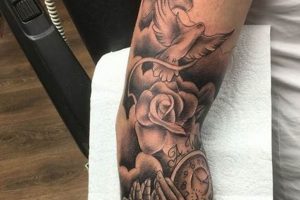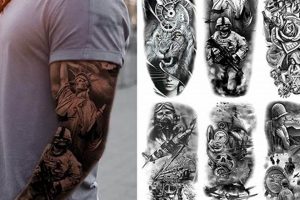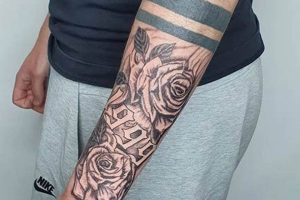A vibrant and cohesive full-arm tattoo requires careful consideration of hues, saturation, and value. This involves selecting a dominant color scheme, complementary accents, and potential transitions between shades to create a visually appealing flow. For instance, a sleeve incorporating a Japanese theme might feature deep reds and blacks with gold highlights, while a nature-inspired design could utilize earthy greens and browns with pops of vibrant floral colors.
Effective color choices enhance the aesthetic impact and narrative depth of a tattoo sleeve. The emotional resonance of specific colors can reinforce the intended symbolism. Historically, color in tattooing has been influenced by cultural traditions and available pigments, evolving from simple blackwork to the complex and varied palettes available today. Skilled artists leverage color theory and the interplay of light and shadow to create visually stunning and meaningful body art.
This article will delve into various stylistic approaches, color palettes, and design considerations for individuals seeking a full-arm tattoo. Practical advice on artist selection, placement, and aftercare will also be provided to ensure a satisfying and lasting piece of body art.
Color Considerations for Tattoo Sleeves
Planning a full-arm tattoo requires careful consideration of color palettes and their impact on the overall design. These tips provide guidance on utilizing color effectively in sleeve tattoos.
Tip 1: Theme and Color Harmony: Establish a clear theme before selecting colors. A cohesive theme allows for a more unified and impactful color palette. For example, a nautical theme might utilize blues and greens, while a fantasy theme might incorporate purples and blacks.
Tip 2: Skin Tone: Consider individual skin tone when choosing colors. Certain colors may appear more vibrant or muted depending on the complexion. Consulting with a skilled tattoo artist can help determine the best pigment choices.
Tip 3: Color Saturation and Value: Varying the saturation and value of chosen colors adds depth and dimension to the design. Strategic use of lighter and darker shades creates visual interest and prevents the tattoo from appearing flat.
Tip 4: Complementary and Contrasting Colors: Utilizing complementary colors can create a visually striking effect, while contrasting colors can highlight specific elements within the design. Understanding basic color theory can significantly enhance the final result.
Tip 5: Color Transitions and Gradients: Smooth transitions between colors create a cohesive and flowing design. Gradients can be used to create a sense of depth and movement within the tattoo.
Tip 6: Long-Term Color Vibrancy: Certain colors, particularly lighter shades, may fade more quickly over time. Discuss colorfastness with the tattoo artist and consider using bolder colors for elements intended to remain prominent.
Tip 7: Placement and Color Visibility: Consider the placement of the tattoo and how clothing might affect the visibility of certain colors. Areas that are frequently covered may not be ideal for showcasing intricate color work.
Careful planning and color selection are crucial for creating a successful and visually stunning tattoo sleeve. These guidelines offer a starting point for individuals seeking a full-arm tattoo, emphasizing the importance of color theory and collaboration with a skilled artist.
By understanding these fundamental principles of color in tattoo design, one can approach the process with greater confidence, ensuring a visually captivating and personally meaningful piece of body art.
1. Color Palette Selection
Color palette selection forms the foundation of a successful tattoo sleeve, significantly influencing the final aesthetic and narrative. A well-chosen palette harmonizes individual elements, creating a cohesive and visually compelling composition. This process requires careful consideration of various factors, including the desired theme, skin tone, and the symbolic meaning of different colors.
- Complementary Colors
Complementary colors, positioned opposite each other on the color wheel, create dynamic contrast and visual interest. For example, a sleeve featuring a Japanese theme might utilize the complementary pairing of red and green, with the red representing good fortune and the green symbolizing nature. Careful balancing prevents visual overload, ensuring one color doesn’t overpower the other.
- Analogous Colors
Analogous colors, located adjacent to each other on the color wheel, evoke a sense of harmony and tranquility. A nature-inspired sleeve might employ shades of green, blue, and yellow to depict a forest scene. This creates a smooth transition between hues, lending a natural and calming feel to the overall design.
- Monochromatic Colors
Monochromatic color palettes utilize variations in the shade and tint of a single color. A sleeve focused on a portrait could employ different shades of black and grey to achieve realism and depth. This approach can create a subtle yet powerful impact, focusing attention on the intricate details of the design.
- Triadic Colors
Triadic color schemes involve three colors evenly spaced on the color wheel. This creates a vibrant and balanced palette. For instance, a geometric tattoo might use red, yellow, and blue to create a visually striking and energetic composition. Careful application is essential to ensure visual harmony and avoid clashing.
The selection of a color palette requires a strategic approach, balancing aesthetic preferences with the desired symbolism and the technical aspects of tattooing. Understanding the interplay of different color schemes allows for a more informed decision, ultimately contributing to a cohesive and impactful tattoo sleeve design that resonates with the individual’s vision.
2. Skin Tone Harmony
Skin tone harmony is a critical factor in successful tattoo sleeve design. Ink reacts differently depending on melanin levels, impacting the vibrancy and longevity of various colors. Understanding this interplay is crucial for achieving the desired aesthetic outcome and ensuring the tattoo ages gracefully. Careful consideration of skin tone allows for informed color choices that complement the individual’s complexion.
- Melanin and Color Vibrancy
Melanin, the pigment responsible for skin color, influences how tattoo ink appears. Higher melanin levels in darker skin tones can mute lighter colors, while darker inks provide stronger contrast. Conversely, lighter skin tones showcase a wider range of colors, but lighter shades may fade more quickly.
- Warm and Cool Undertones
Skin undertones, classified as warm, cool, or neutral, also affect color presentation. Warm undertones complement earthy tones and warmer colors like oranges and yellows. Cool undertones work well with blues, greens, and purples. Identifying one’s undertone is essential for optimizing color choices within the tattoo design.
- Color Saturation and Skin Tone
Color saturation plays a significant role in how a tattoo appears on different skin tones. Highly saturated colors may appear more vibrant on darker skin, while pastel shades may be more noticeable on lighter skin. Adjusting saturation levels based on skin tone ensures the desired impact.
- Consultation with a Skilled Artist
Professional tattoo artists possess expertise in color theory and skin tone interaction. Consultation with an experienced artist is invaluable. They can assess skin tone, recommend suitable colors, and adjust pigment saturation to achieve optimal results. Their guidance ensures a cohesive and visually appealing design that complements the individual’s complexion.
Considering skin tone harmony during the design process is paramount for creating a visually stunning and long-lasting tattoo sleeve. Careful color selection and collaboration with a skilled artist ensure that the final artwork complements the individual’s unique complexion and fulfills their artistic vision.
3. Color Saturation
Color saturation plays a crucial role in the overall impact and longevity of a tattoo sleeve. Saturation refers to the intensity or purity of a color. Highly saturated colors appear vibrant and bold, while less saturated colors appear muted or pastel. Within a complex design like a sleeve, varying saturation levels adds depth, visual interest, and directs the viewer’s eye. For example, a sleeve depicting a realistic portrait might utilize highly saturated colors for the subject’s clothing, while less saturated colors might be used for the background to create a sense of depth and focus. The interplay of varying saturations allows artists to create contrast and emphasis within the composition.
The choice of saturation levels also influences how the tattoo ages. Highly saturated colors, while initially vibrant, can fade more quickly, especially lighter shades like yellows and pinks. Less saturated colors tend to hold their integrity over time, making them suitable for background elements or details intended to remain subtle. Understanding these principles allows for strategic color choices that maintain the desired aesthetic over the long term. For instance, a sleeve incorporating a floral motif might utilize highly saturated colors for the central flower, while using less saturated greens for the leaves and stems, ensuring the focal point remains prominent as the tattoo ages.
Effective saturation management is a key skill in tattoo artistry. It allows for the creation of visually dynamic and balanced compositions that retain their impact over time. Careful consideration of color saturation in the planning phase, coupled with an understanding of how different colors age, is crucial for realizing a successful and enduring tattoo sleeve design. This awareness, combined with artistic expertise, results in a harmonious blend of color and composition, achieving the desired aesthetic and longevity.
4. Contrast and Vibrancy
Contrast and vibrancy are essential elements in impactful tattoo sleeve designs. Strategic use of contrasting colors and varying levels of vibrancy contribute significantly to the overall aesthetic, creating depth, visual interest, and directing the viewer’s gaze. Skilled manipulation of these elements enhances the narrative and ensures the design remains captivating over time. A clear understanding of how contrast and vibrancy interact is crucial for achieving a successful and lasting piece of body art.
- Color Juxtaposition
Juxtaposing complementary colors, such as red and green or blue and orange, creates strong visual contrast. This technique can be used to highlight specific elements within the design or to create a sense of dynamic energy. Careful placement of contrasting colors prevents visual overload and ensures a balanced composition. For example, a sleeve featuring a koi fish might use vibrant orange for the fish against a deep blue background, creating a striking contrast that emphasizes the subject.
- Vibrancy and Visual Impact
Vibrancy, determined by color saturation, dictates the intensity of a color. Highly vibrant colors draw attention and create a sense of boldness, while less vibrant colors create a more subdued effect. Varying vibrancy within a sleeve adds depth and visual interest. For instance, a floral design might use highly vibrant colors for the blossoms and less vibrant greens for the leaves and stems, creating a natural focal point.
- Contrast and Depth Perception
Contrasting light and dark values create an illusion of depth and dimension. Darker colors recede visually, while lighter colors advance. This principle can be applied to create a sense of three-dimensionality within the tattoo. For example, a sleeve depicting a landscape might use darker values for distant elements and lighter values for closer elements, enhancing the sense of perspective.
- Long-Term Vibrancy Considerations
Certain colors, particularly lighter and more vibrant shades, are prone to fading over time. Understanding colorfastness and planning for potential fading is essential for maintaining the desired aesthetic. Strategic use of darker, more stable colors for key elements ensures the design remains visually appealing as it ages. For instance, outlining key elements in black ink can help maintain definition and prevent the design from blurring over time.
Masterful application of contrast and vibrancy elevates tattoo sleeve designs from simple illustrations to dynamic and captivating works of art. By understanding these principles and working with a skilled artist, individuals can ensure their tattoo remains a visually stunning and personally meaningful expression for years to come. Effective use of contrast and vibrancy not only enhances the aesthetic appeal but also contributes to the longevity and enduring impact of the artwork.
5. Transitional Blending
Transitional blending is a critical technique in achieving cohesive and visually appealing tattoo sleeves. It involves seamlessly graduating between colors, creating a smooth flow rather than abrupt changes. This technique contributes significantly to the overall aesthetic by unifying diverse elements within the design. The effectiveness of color choices within a tattoo sleeve is amplified by skillful blending, ensuring a harmonious and natural appearance. For example, a sleeve depicting a sunset might utilize transitional blending to create a smooth gradient from warm oranges and yellows to cooler purples and blues, mimicking the natural transition of colors in the sky. Without proper blending, the distinct color blocks would appear jarring and detract from the overall composition. Transitional blending also plays a crucial role in depicting realistic textures and shadows, adding depth and dimension to the artwork. A skilled artist can blend colors to create the illusion of light and shadow, making elements appear more three-dimensional and lifelike.
The importance of transitional blending extends beyond aesthetics. It impacts the perceived size and shape of the tattoo. Smooth transitions can elongate or shorten certain areas, creating a more balanced and proportionate composition. For instance, in a sleeve featuring a dragon, blending can be used to emphasize the curves and contours of the creature, giving it a more dynamic and fluid appearance. Furthermore, effective blending minimizes the risk of the tattoo appearing fragmented or disjointed, particularly in complex designs incorporating multiple elements and color palettes. This cohesive integration of various components is essential for a visually satisfying and impactful final result.
In summary, transitional blending is an essential component of successful tattoo sleeve design. It enhances the visual appeal by creating smooth transitions between colors, adds depth and dimension through realistic shading, and contributes to the overall composition by unifying disparate elements. Mastery of this technique allows artists to create cohesive and visually stunning artworks that stand the test of time. Understanding the significance of transitional blending empowers individuals to make informed decisions when planning their tattoo sleeves, ensuring a harmonious and impactful final result that reflects their artistic vision.
6. Symbolic Color Meanings
Color choices in tattoo sleeves extend beyond aesthetics; they often carry profound symbolic meanings. These meanings, deeply rooted in cultural and personal contexts, contribute significantly to the narrative and emotional depth of the design. Understanding the symbolism associated with different colors allows for a more informed and meaningful approach to tattoo sleeve planning, ensuring the artwork resonates on a deeper level.
- Cultural Significance
Color symbolism varies significantly across cultures. For instance, red symbolizes good fortune and prosperity in some Eastern cultures, while in Western cultures, it can represent passion or danger. Incorporating colors relevant to one’s cultural heritage can add a layer of personal significance to the tattoo. A sleeve incorporating traditional Japanese imagery might utilize red for good luck and black for protection, reflecting the cultural context of the design.
- Personal Associations
Individuals often ascribe personal meanings to specific colors based on experiences and emotional connections. Blue might evoke feelings of tranquility for one person, while representing sadness for another. Integrating colors with personal resonance allows for a deeply individualized and emotionally charged artwork. A sleeve dedicated to a loved one might incorporate their favorite color, adding a sentimental layer to the design.
- Emotional Resonance
Colors possess inherent emotional qualities. Warm colors like red and orange often evoke feelings of energy and excitement, while cool colors like blue and green can elicit calmness and serenity. Strategic use of color can evoke specific emotions within the viewer, enhancing the overall impact of the tattoo. A sleeve intended to convey a sense of strength and power might predominantly feature warm, vibrant colors.
- Color Psychology in Tattooing
While color associations can be subjective, certain psychological principles apply. Darker colors often represent mystery and sophistication, while lighter colors symbolize purity and innocence. Understanding these principles can enhance the intended message of the tattoo. A sleeve exploring themes of duality might utilize black and white to represent opposing forces.
By carefully considering the symbolic meanings associated with different colors, individuals can create tattoo sleeves that resonate on multiple levels. The interplay of cultural significance, personal associations, and emotional resonance transforms the artwork into a powerful form of self-expression, imbuing the design with deeper meaning and lasting impact. A well-planned color palette not only enhances the aesthetic appeal of the tattoo but also tells a story, reflecting the individual’s unique identity and worldview.
7. Long-Term Color Fastness
Long-term color fastness is a critical consideration when planning a tattoo sleeve. The vibrancy and clarity of a design can significantly diminish over time due to factors like sun exposure, skin cell regeneration, and ink quality. Certain colors, particularly lighter shades like yellow and pink, are more susceptible to fading. This fading can alter the intended aesthetic and compromise the overall composition. Therefore, color choices must prioritize longevity alongside artistic vision. Choosing high-quality inks formulated for long-term vibrancy is paramount. For example, a sleeve incorporating pastel hues requires careful consideration of colorfastness to maintain its intended softness and prevent premature fading. Likewise, a design featuring intricate details relies on the longevity of the chosen colors to preserve its clarity and prevent blurring over time. Neglecting colorfastness can lead to a muted or distorted final result, diminishing the impact of the artwork.
Practical steps can mitigate color degradation. Protecting the tattoo from prolonged sun exposure through appropriate clothing or sunscreen with a high SPF is crucial. Regular moisturizing helps maintain skin health, which indirectly contributes to color retention. Choosing a skilled and experienced tattoo artist is equally important. Experienced artists possess in-depth knowledge of ink properties and can recommend pigments known for their durability. They also employ proper techniques that minimize trauma to the skin during application, promoting better ink retention. For instance, an artist might recommend slightly darker shades of a desired color to account for potential fading, ensuring the final result remains closer to the intended vision over time. Consulting with an artist about aftercare practices further optimizes color longevity. These practices include avoiding harsh soaps and chemicals during the healing process and following recommended moisturizing routines.
In conclusion, long-term color fastness is an integral aspect of successful tattoo sleeve design. Color choices, ink quality, sun protection, moisturizing, artist selection, and aftercare practices all contribute significantly to maintaining the vibrancy and clarity of the artwork over time. Careful consideration of these factors ensures the tattoo retains its intended aesthetic impact and remains a source of personal expression for years to come. Addressing colorfastness proactively not only preserves the visual integrity of the design but also demonstrates a commitment to the long-term enjoyment and appreciation of the artwork.
Frequently Asked Questions
Addressing common inquiries regarding color selection and application in tattoo sleeves provides clarity and facilitates informed decision-making. The following responses offer practical insights and dispel common misconceptions.
Question 1: How does skin tone affect color vibrancy in tattoo sleeves?
Melanin levels significantly influence ink vibrancy. Darker skin tones may mute lighter colors, requiring careful pigment selection for optimal results. Conversely, lighter skin tones showcase a wider range of hues but may experience faster fading, especially with lighter shades. Consultation with a skilled artist is crucial for determining appropriate color saturation and ensuring long-term vibrancy.
Question 2: Which colors are most prone to fading in tattoo sleeves?
Lighter colors, particularly yellows, pinks, and light greens, tend to fade more quickly than darker, more saturated colors. Sun exposure accelerates this process. Protective measures, such as sunscreen and appropriate clothing, can help mitigate fading.
Question 3: How can one ensure long-term color vibrancy in a tattoo sleeve?
Several factors contribute to color longevity, including high-quality inks, proper application techniques, and consistent aftercare. Protecting the tattoo from sun exposure and maintaining healthy skin hydration also play significant roles. Consulting with an experienced artist about colorfastness and appropriate aftercare practices is highly recommended.
Question 4: What is the role of color theory in planning a tattoo sleeve?
Color theory principles guide effective color palette selection. Understanding complementary, analogous, and triadic color schemes assists in creating harmonious and visually appealing compositions. Applying these principles ensures a balanced and impactful design.
Question 5: How does color symbolism influence tattoo sleeve design?
Colors hold symbolic meanings that vary across cultures and personal experiences. Incorporating colors with relevant symbolism can add depth and narrative to the artwork. Researching cultural associations and considering personal connections to specific colors allows for a more meaningful design.
Question 6: What is the significance of color saturation in tattoo sleeves?
Color saturation, the intensity or purity of a color, impacts both the visual impact and longevity of a tattoo. Highly saturated colors appear vibrant but may fade more quickly. Varying saturation levels within a design adds depth and visual interest while considering long-term colorfastness ensures the intended aesthetic is maintained.
Understanding these key aspects of color selection and application contributes to informed decisions and facilitates the creation of successful, visually stunning, and personally meaningful tattoo sleeves.
Continue reading for a comprehensive guide on selecting the right tattoo artist for your sleeve project.
Conclusion
Effective implementation of color within a tattoo sleeve necessitates a comprehensive understanding of various interconnected factors. Careful consideration of color palettes, skin tone harmony, saturation levels, contrast, vibrancy, transitional blending, symbolic meanings, and long-term color fastness is crucial for achieving a visually compelling and enduring artwork. These elements contribute not only to the aesthetic appeal of the tattoo but also to its narrative depth and personal significance. A holistic approach, integrating these considerations from the initial design phase, ensures a harmonious and impactful final result.
A well-executed tattoo sleeve transcends mere aesthetics; it becomes a powerful form of self-expression, a visual narrative etched onto the skin. The thoughtful application of color elevates the design, transforming it into a dynamic and enduring piece of art. By embracing the complexities of color theory and collaborating with skilled artists, individuals can embark on a transformative journey, culminating in a truly unique and personally meaningful artwork that stands the test of time.







